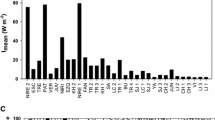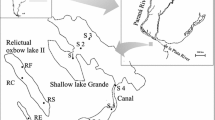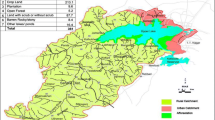Abstract
The mid-summer phytoplankton communities of more than 100 Adirondack lakes ranging in pH from 4.0 to 7.2 were characterized in relation to 25 physical-chemical parameters. Phytoplankton species richness declined significantly with increasing acidity. Acidic lakes (pH < 5.0) averaged fewer than 20 species while more circumneutral waters (pH > 6.5) averaged more than 33 species. Phytoplankton abundance was not significantly correlated with any of the measured physical-chemical parameters, but standing crop parameters, i.e., chlorophyll a and phytoplankton biovolume, did correlate significantly with several parameters. Midsummer standing crop correlated best with total phosphorus concentration but acidity status affected the standing crop-phosphorus relationship. Circumneutral waters of low phosphorus content, i.e. < 10 µg·1−1 TP, averaged 3.62 µg·1−1 chlorophyll a whereas acidic lakes of the same phosphorus content averaged only 1.96 µg·1−1 chlorophyll a. The midsummer chlorophyll content of lakes of high phosphorus content, i.e. > 10 µg·1−1 TP, was not significantly affected by acidity status.
Adirondack phytoplankton community composition changes with increasing acidity. The numbers of species in midsummer collections within all major taxonomic groups of algae are reduced with increasing acidity. The midsummer phytoplankton communities of acidic Adirondack lakes can generally be characterized into four broad types; 1) the depauperate clear water acid lake assemblage dominated by dinoflagellates, 2) the more diverse oligotrophic acid lake community dominated by cryptomonads, green algae, and chrysophytes, 3) the productive acid lake assemblage dominated by green algae, and 4) the chrysophyte dominated community. The major phytoplankton community types of acid lakes are associated with different levels of nutrients, aluminum concentrations, and humic influences.
Similar content being viewed by others
References
Almer, B., W. Dickson, C. Ekstrom, E. Hornstrom & U. Miller, 1974. Effects of acidification of Swedish lakes. Ambio 3: 30–31.
Almer, B., W. Dickson, C. Ekstrom & E. Hornstrom, 1978. Sulfur pollution and the aquatic ecosystem. In J. O. Nriagn (ed.) ‘Sulfur in the Environment, Part II: Ecological Impacts,’ Wily, New York: 271–311.
Bird, D. F. & J. Kalff, 1986. Bacterial grazing by planktonic lake algae. Science 231: 493–495.
Charles, D. F., 1985. Relationships between surface sediment diatom assemblages and lake water characteristics in Adirondack lakes. Ecology 66: 994–1011.
Conroy, N., R. Hawley, W. Keller, and C. LaFrance, 1976. Influences of the atmosphere on lakes in the Sudbury Area. J. Great Lakes Res 2 (Suppl 1)1: 146–165.
Conway, J. L. & C. R. Hendrey, 1982. Ecological effects of acid precipitation on primary producers. In F. M. D'Itri (ed.), ‘Acid Precipitation: Effects on Ecological Systems,’ Ann Arbor Science Publ., Ann Arbor, MI: 277–295.
Dillon, P. S. & F. G. Rigler, 1974. The phosphorus-chlorophyll relationship in lakes. Limnol. Oceanogr. 19: 767–773.
Hendrey, G. R., 1980. Effects of acidity on primary productivity in lakes: phytoplankton. In D. Shriner, C. Richmond, & S. Lindberg (eds.), Atmospheric Sulfur Deposition — Environmental Impact and Health Effects, Ann Arbor Science, Ann Arbor, MI: 357–371.
Hendrey, G. R., J. N. Galloway & C. L. Schofield, 1980. Temporal and spatial trends in the chemistry of acidified lakes under ice cover. In D. Drablos & A. Tollan, (eds.), Proc. Int. Conf. Impact Acid Precip., Norway, SNSF Project: 266–267.
Hendrey, C. R., N. D. Yan, & K. J. Baumgartner, 1981. Response of freshwater plants and invertebrates to acidification. Restoration of Lakes and Inland Waters, U.S.E.P.A., EPA 440/5–81–010: 457–466.
Hultberg, H. & I. Anderson, 1982. Liming of acidified lakes: induced long-term changes. Water Air Soil Pollut. 18: 311–331.
Kwiatkowski, R. & J. Roff, 1976. Effects of acidity on the phytoplankton and primary productivity of selected northern Ontario lakes. Can. J. Botany 54: 2546–2561.
Leiverstad, H., C. Hendrey, I. P. Muniz & E. Snekuik, 1976. Effects of acid precipitation on freshwater organisms. In F. H. Braekke, (ed.) ‘Impact of Acid Precipitation on Forest and Freshwater Ecosystems in Norway’, SNSF Res. Rept. 6/79, Oslo, Norway: 86–111.
Magnuson, J. F., F. J. Rahel, R. Singer, J. H. Peverly, J. P. Raker, K. Fischler, G. Driscoll, & G. C. Schafarn, 1984. Effects on aquatic biology, Chapter F-5 in R. A. Linthurst (ed.), The Acidic Deposition Phenomenon and its Effects, Critical Assessment Review papers, Vol. 11, Effects Sciences, EPA-600/8–83.
Mills, K. H. & D. W. Schindler, 1986. Biological indicators of lake acidification. Water, Air, and Soil Pollution 30: 779–789.
National Research Council of Canada, 1981. Acidification in the Canadian Aquatic Environment: Scientific Criteria for Assessing the Effects of Acidic Deposition on Aquatic Ecosystems. NRCC, No. 18475, 369 pp.
Nicholls, K. H. & P. J. Dillon, 1978. An evaluation of phosphorus-chlorophyll-phytoplankton relationships for lakes. Int. Rev. Ges. Hydrobiol. 63: 141–154.
Overrein, L. N., H. M. Seip & A. Tollan, 1980. Acid Precipitation: Effects on Forest and Fish. Final Report. SNSF Project 1972–1980. Oslo-As, Norway.
Park, R. A., 1968. Paleoecology of Venericardia sensu lato (Pelecypoda) in the Atlantic and Gulf coastal province: an application of paleosynecologic methods. J. Paleontol. 42: 955–986.
Quinn, S., C. A. Siegried, J. A. Bloomfield, J. W. Sutherland & R. Weinbloom, 1988. The chemistry of fifty Adirondack mountain lakes in relation to acidification. EPA/NCSU Acid Deposition Program Contract Final Rep. No. APP-0325–1983.
Raddum, G., A. Holback, E. Lomsland & T. Johnsen, 1980. Phytoplankton and zooplankton in acidified lakes in south Norway. In Drablos & Tollen: 332–333.
Schindler, D. W., 1971. Carbon, nitrogen, and phosphorus and the eutrophication of freshwater lakes. J. Phycol. 7: 321–329.
Schindler, D. W., K. H. Mills, D. F. Malley, D. L. Findlay, J. A. Shearer, I. J. Davies, M. A. Turner, G. A. Linsey & D. R. Cruikshank, 1985. Long-term ecosystem stress: the effects of years of experimental acidification on a small lake. Science 228: 1395–1401.
Siegfried, G. A., 1988. Planktonic indicators of lake acidification in the Adirondack mountain region of New York State. Lake Reserv. Manage. 4: (in press).
Siegfried, C. A. and S. O. Quinn. 1986. Lake George Clean Lakes 314 Study (Phase I — Diagnostic/Feasibility Study). Final Rept. to USEPA, NYS Dept. Environ. Conserv., Albany, N.Y., 407 pp.
Siegfried, C. A., J. W. Sutherland, S. O. Quinn & J. A. Bloomfield, 1984. Lake acidification and the biology of Adirondack lakes: I. Rotifer communities. Verh. Int. Ver. Limmol. 22: 549–558.
Smol, J. P., D. F. Charles, & D. R. Whitehead, 1984a. Mallomonadacean (Chrysophyceae) assemblages and their relationships with limnological characteristics in 38 Adirondack (New York) lakes. Can. J. Bot. 62: 911–923.
Smol, J. P., D. F. Charles, & D. R. Whitehead, 1984b. Mallomonadacean microfossils provide evidence of recent lake acidification. Nature 307: 628–630.
Sokal, R. R. & F. J. Rohlf, 1981. Biometry. W. H. Freeman and Co., New York. 859 pp.
Sorensen, T., 1948. A method of establishing groups of equal amplitude in plant sociology based on similarity of species content and its application to analyses of the vegetation on Danish commons. Biol. Skr. 5: 1–34.
Sutherland, J. W., S. O. Quinn, J. A. Bloomfield & C. A. Siegfried, 1984. Lake acidification and the biology of Adirondack lakes: Crustacean zooplankton communities. Lake Reserv. Manag. EPA 440/5/84–001: 380–384.
Wood, L. W., 1978. Limnology of remote lakes in the Adirondack region of New York State with emphasis on acidification problems. Environ. Health Rept. No. 4, NYS Dept. Health, Albany, NY, 65 pp.
Yan, N. D., 1979. Phytoplankton community of an acidified, heavy metal-contaminated lake near Sudbury, Ontario: 1973–1977. Water, Air and Soil Pollution 11: 43–55.
Yan, N. D. & P. Stokes, 1978. Phytoplankton of an acidic lake and its response to experimental alterations of pH. Environ. Conservation 5: 93–100.
Author information
Authors and Affiliations
Rights and permissions
About this article
Cite this article
Siegfried, C.A., Bloomfield, J.A. & Sutherland, J.W. Acidity status and phytoplankton species richness, standing crop, and community composition in Adirondack, New York, U.S.A. lakes. Hydrobiologia 175, 13–32 (1989). https://doi.org/10.1007/BF00008472
Received:
Revised:
Accepted:
Issue Date:
DOI: https://doi.org/10.1007/BF00008472




